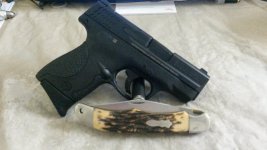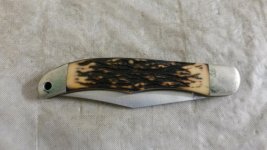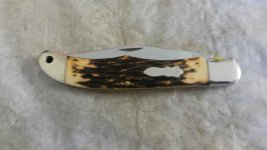Bear in mind that my "advise" (should read "advice") was intended to restore to normal use modern knives without vast collector value.
Carefully polishing stains or scratches off the blade or bolsters of a modern stainless folder to improve the knife's looks for a daily use implement is not akin to shining an old rusty blade on a rare Case collectible from the 1920's.
I'd be a poor collector or investor. I like my guns and knives to look good and work well. I try to keep them looking as new as possible. I'm not one of these guys who'd buy an old M&P or .38-44 S&W that looks like someone with an ugly stick just ran through its barracks. (Any of you older guys with USAF service ever heard that line about the WAF barracks?

)
If I bought a worn older gun it'd be to fully restore it to former glory (usually expensive beyond all reason) and then to use it with care, from a nice lined holster. I don't buy "user grade" or "truck guns." I view my knives the same way, and avoid old, rusty stuff.
That said, I'm glad that collectors do preserve these old relics and try to restore them as much as possible, within the guidelines of their hobby. They're important pieces of history and are wonderful from a nostalgia standpoint.
My tendency is to buy only reasonably modern knives that have stainless high carbon blades and which are in good shape. I did once return a used Buck Model 120 to the maker for refinishing. They did a great job, with fast turnaround.
But I normally buy new or as-new items and take care of them. And I carry my knives. I don't collect them in the technical sense of the term and store them in knife rolls, etc.
Some are fairly valuable, but I don't get them as investments. I get them because they're beautiful and suit my sense of style.
The OP's knife is not a rare or old collectible. It just needs some basic TLC to become an heirloom in that family or to be restored to normal use.
With these different philosophies in mind, both Remchester and I are correct in our advice. And I thank him for the bit about using steel wool to clean the rusty interiors of old pocketknives.
I just don't want to panic the owners of Uncle Henry knives into thinking that they're destroying a rare collectible by polishing scratches off the satin-finished stainless blade of a modern "using" knife.
BTW, I usually hone carefully on ceramic crock sticks, to avoid scratching blades while honing on a stone. If you never let the knife get really dull, this works well and avoids sharpening away the blade in repeated honings over the years. I've seen pics of blades on this board that were severely worn as a result of over sharpening.








